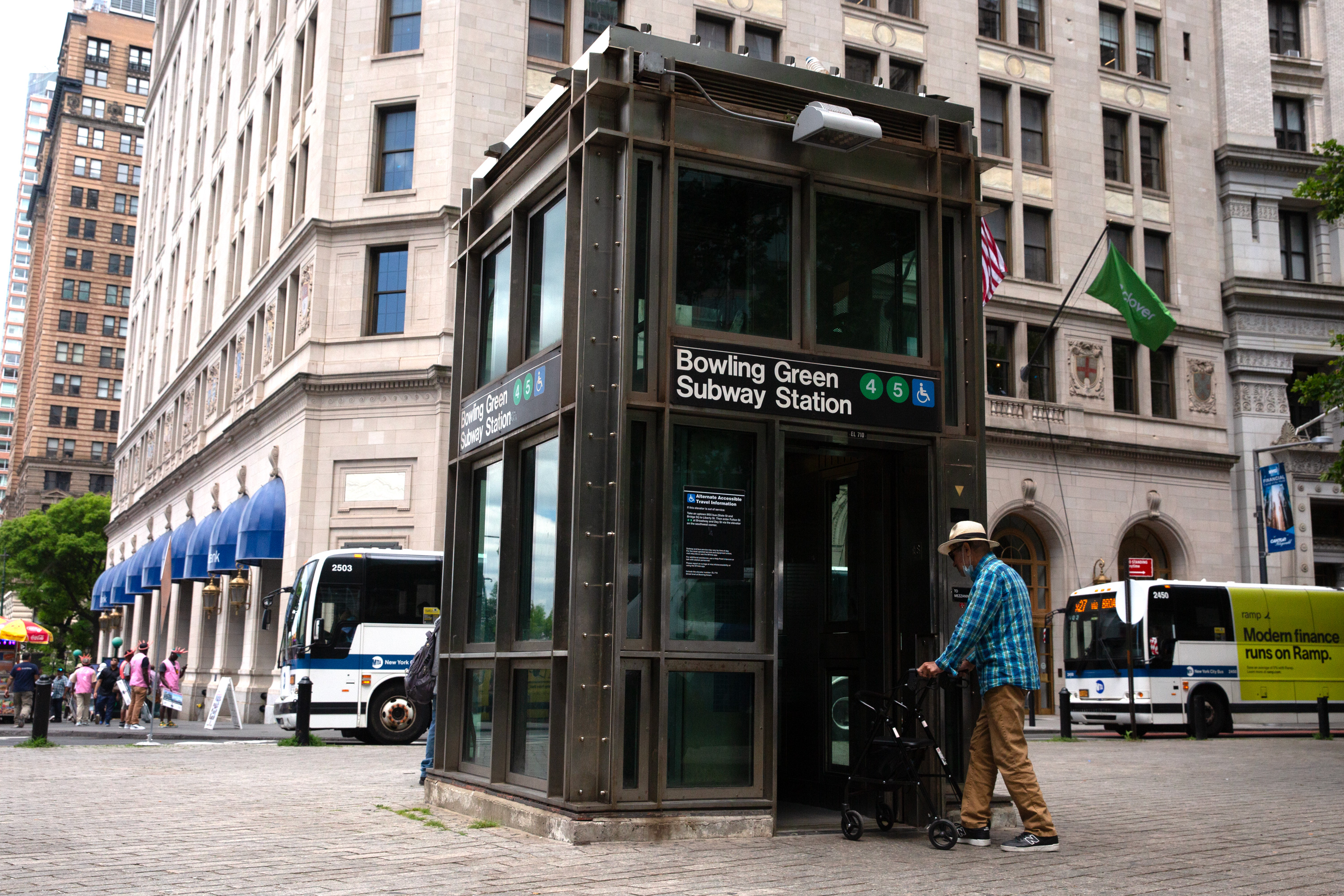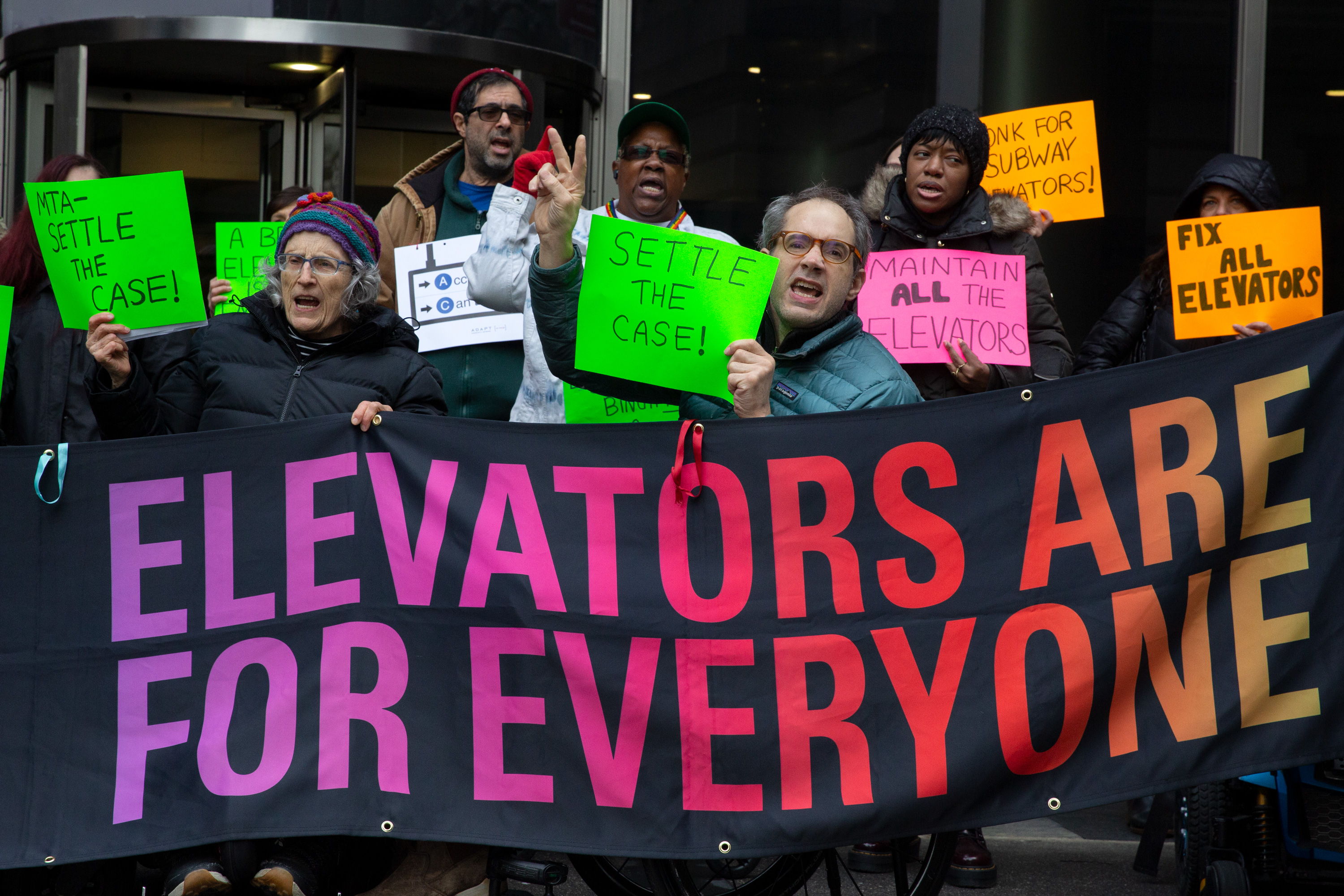Just under two years ago, many of the MTA’s harshest critics cheered as the transit agency’s chairman touted “a truly historic day” for New York and for civil rights — when a federal court settlement mandated that almost all stations become accessible to people with disabilities by 2055.
“It was a really big deal,” said Jessica Murray, an organizer with the Rise and Resist Elevator Action Group, which advocates for expanding elevator access in the subway. “For a minute, we were like friends.”
But after Gov. Kathy Hochul last week paused the June 30 start of congestion pricing tolling for vehicles entering core Manhattan, which was to raise billions of dollars for MTA capital improvements, the agency now faces the prospect of delaying its legal commitment to install elevators or ramps at hundreds of subway stations.
MTA chairman and CEO Janno Lieber on Monday conceded that the June 2022 settlement requiring the MTA to make stations accessible has an escape hatch for “downside scenarios.”
That legalese means that if the MTA does not meet certain funding goals, a lower share of its total capital budget will need to be allocated toward making stations compliant with the Americans With Disabilities Act, slowing the promised accessibility upgrades.
Chloe Holzman, a senior staff attorney with Disability Rights Advocates, the nonprofit legal rights center that represented the plaintiffs in the class-action case, said the MTA will be held to the terms of the settlement.
“With the loss of congestion as a source of funding, it is true that we are concerned it could affect the speed at which the milestones are met,” Holzman told THE CITY.

After Hochul swiftly backed away from the congestion pricing program that she herself had championed at rallies last year alongside MTA leaders, Lieber said that the agency will now have to “resequence and shrink” its current $50 billion-plus capital plan, a move with major implications for accessibility work that had previously been on the fast track.
He also said he assigned Quemuel Arroyo, the MTA’s chief accessibility officer, to “make sure that we squeeze out as much station accessibility work as possible”
“Our commitments that we’ve made to the disability community, as part of that legal settlement a couple of years ago, do have provisions in them for downside scenarios,” Lieber told reporters. “But we want this to be a collaborative exercise and I want Quemuel to work intensively for them as we figure out what we can do — which is going to be less — and what we prioritize.”
The MTA presently has accessibility work underway at 38 stations, a spokesperson said, and 151 stops are already in compliance with the ADA. In all, that’s 30% of the 493 stations that make up the New York City subway system and the Staten Island Railway.
Under the terms of the 2022 settlement, most of those stations are supposed to be fully accessible by 2055, with the MTA agreeing to designate “no less than 14.69%” from all future five-year capital programs to fund for creating accessible stations.
But one of the contingency provisions of the settlement, for example, stipulates that “if the Transit Facilities Funding amount is ultimately less than $35.389 [billion] but not less than $30 billion, the [MTA] will commit to designating no less than 12% of that amount to creating Accessible Stations.”
In the current $55 billion capital plan, the MTA said $28 billion of work remains overall. But with the pool of money shrunk by a projected $15 billion due to the loss of the revenue that would have been raised by tolling vehicles that enter Manhattan south of 60th Street, a sizable transformation of the agency’s largest-ever capital program may be inevitable.
Joseph Rappaport, executive director of Brooklyn Center for Independence of the Disabled, an advocacy group that was among the organizations that sued the MTA over accessibility, said Hochul and state lawmakers must now come up with other sources of funding to meet the legal obligation.
“Accessibility is not a balloon that you toss back and forth between the legislature and the governor until it pops,” Rappaport told THE CITY. “They actually have to come through.”
‘Part of the Process’
The governor’s backtracking on what is officially known as the Central Business District Tolling Program has drawn furor from environmental and transit advocates. The head of the MTA acknowledged that Hochul’s last-minute maneuver will come with a cost.
“The governor plays on a statewide and a national field, and sometimes that means we don’t look at things exactly the same,” Lieber said Monday.
Mayor Eric Adams on Tuesday said he had talked with the governor and Lieber about the pause.
“I spoke with Janno yesterday as he talked about some of the impacts on our capital [program],” he said. He did not come out strongly for or against the change and had told THE CITY on Saturday, “It’s all part of the process.”
Meanwhile, city Comptroller Brad Lander on Tuesday said he is planning to make a congestion pricing-related announcement about assembling a panel of experts to look for legal avenues to keep congestion pricing on track.

Hochul has insisted she is not walking away from long-planned improvements to the transit system as much as she is putting a pause on congestion pricing and pledging to continue the work through “alternative funding.”
“I am committed to these projects,” she said Monday. “I have told everybody I am committed to these projects.”
But in a Friday night MTA statement, two top agency officials cited how “modernization and improvement projects” — such as electric buses, new signals and accessible stations — will likely become lower-priority when stacked against the transit system’s “basic operation and functionality” without a clear funding stream for the future.
Accessibility advocates were already aware of the budget vulnerability.
“I knew this provision was in the settlement agreement and I figured it would come into play somewhere down the road,” said Murray, of the Elevator Action Group. “I just was not expecting it so soon.
“Congestion pricing isn’t just about this capital plan, but it’s an ongoing source of revenue in the future,” she added. “Now it just seems to put the entire [accessibility] settlement at risk.”
Dustin Jones, a wheelchair user and disability-rights advocate, said he is hopeful that the MTA will ultimately meet its obligation to equip 95% of all stations with elevators or ramps, even if it means missing the 2055 goal — a potential outcome that he blasted as “a disgrace.”
“I’m pretty sure once the elections are done, Kathy Hochul will think of another way to get congestion pricing unpaused,” Jones told THE CITY. “If you have a legally binding settlement, you don’t take something that you’re legally bound to do and then put it on the back burner.”
Additional reporting by Katie Honan.

